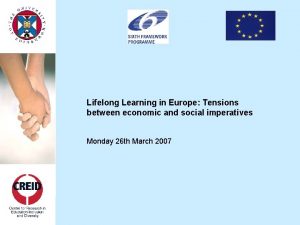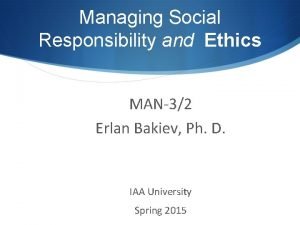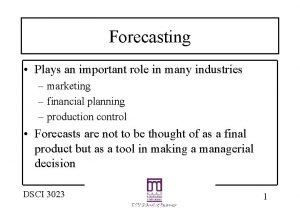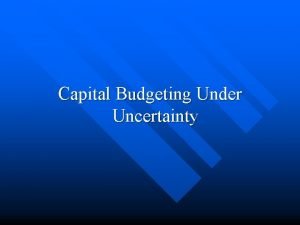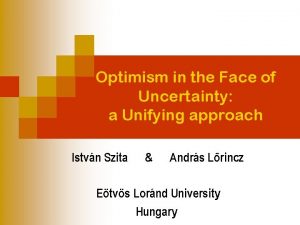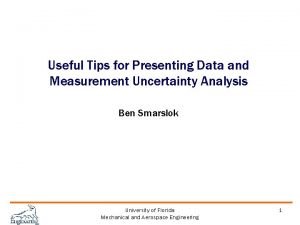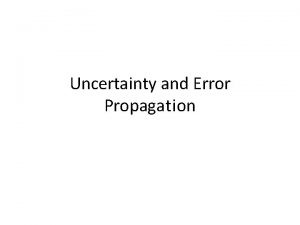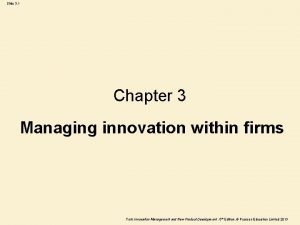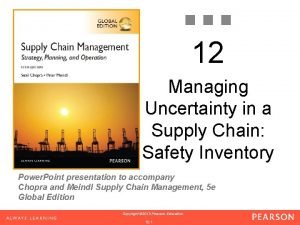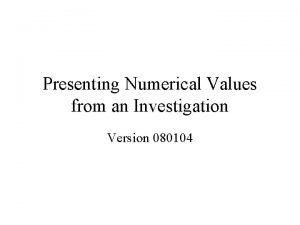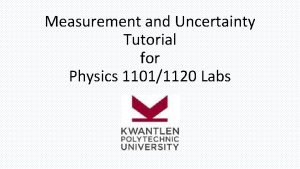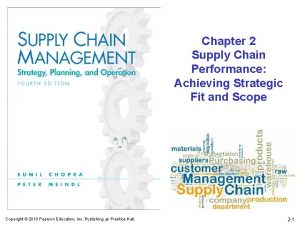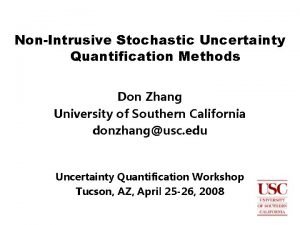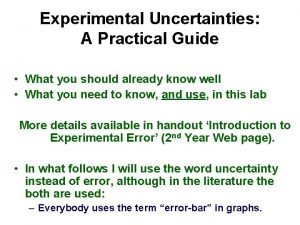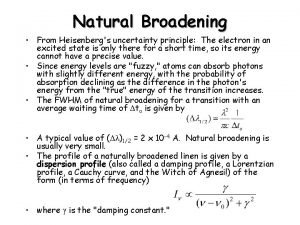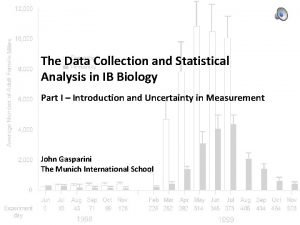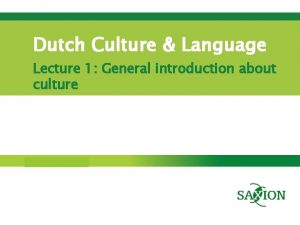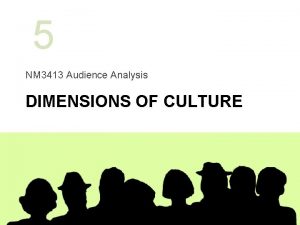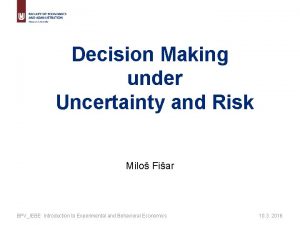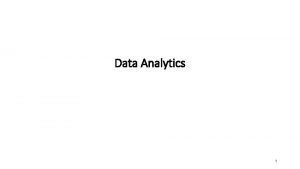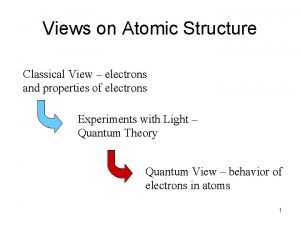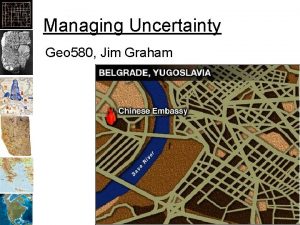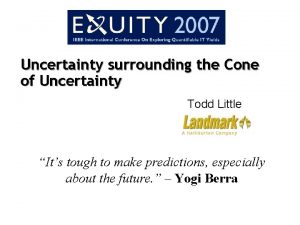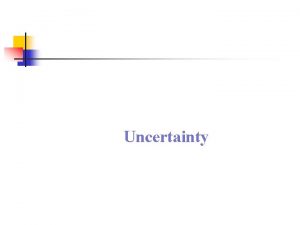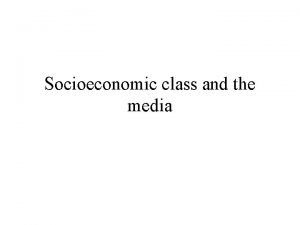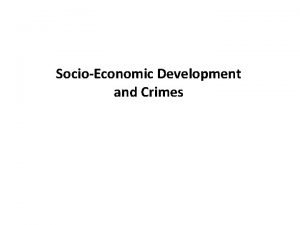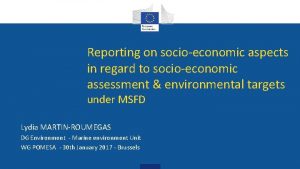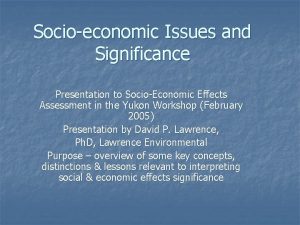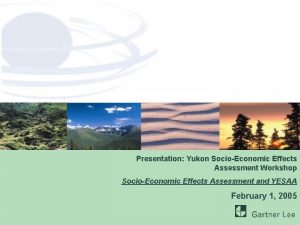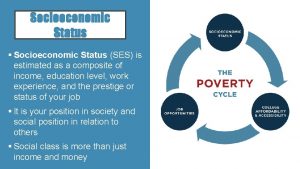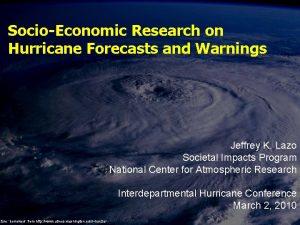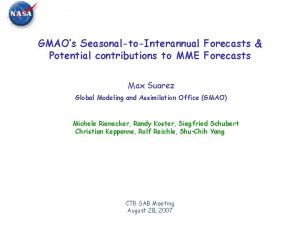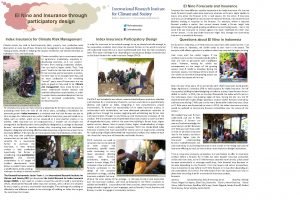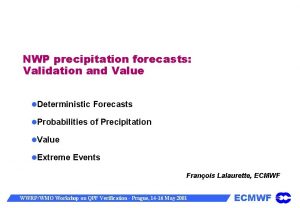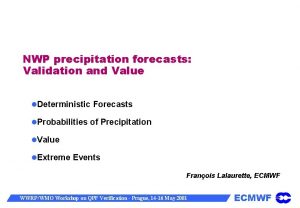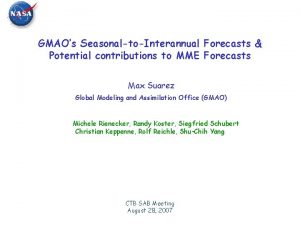Uncertainty in socioeconomic forecasts Todd Graham todd grahammetc


































- Slides: 34

Uncertainty in socioeconomic forecasts Todd Graham <todd. graham@metc. state. mn. us> Metropolitan Council Research

Why forecast? n Provides a reasonable basis for planning ¨ local comprehensive planning ¨ regional system planning Engages stakeholders in addressing growth issues n Helps us understand trends and forces n Forces us to articulate our expectations n 9/11/2021 2

Forecast certainty is not possible DF = Development Framework SD = State Demographer 9/11/2021 3

Many futures are possible n Many scenarios are possible ¨ What do we imagine is the end-state? ¨ What path takes us there? n Starting assumptions that will constrain the range of possibilities ¨ Narrowing 9/11/2021 from the possible to the probable 4

Where does forecasting come in? n Forecast modeling is a system analysis ¨ To represent a set of variables over time ¨ And to represent the dynamics and relationships that move those variables Probable range of futures n Or the most probable future… n ¨ Given a basket of system dynamics, trends, policies, other assumptions 9/11/2021 5

Are multiple forecasts possible? Probable range of futures n Or the most probable future… n ¨ Given a basket of system dynamics, trends, policies, other assumptions 9/11/2021 6

Twin Cities Population Possibilities Range All High Thousands Hi Fert. Hi Migr. Hi Life Exp. Lo Life Exp. All Mid Lo Fert. Lo Migr. All Low 9/11/2021 7

The most probable future(s)? n System dynamics and trends ¨ Can be tweaked as appropriate by forecaster ¨ Or trends can be endogenously modeled, or loaded in from other related models n Policies are variable ¨ Different scenarios to explore policy options ¨ Policymakers decide; forecasters assist ¨ Result is a policy-based forecast – the desired future 9/11/2021 8

Challenges and opportunities Improvement of modeling practices n Integration or coordination of parallel forecast efforts n Engagement of policymakers, planners and publics n 9/11/2021 9

The Future of Forecasts at Met Council Todd Graham <todd. graham@metc. state. mn. us> Metropolitan Council Research

Metropolitan Council’s current model REGIONAL • Jobs • Households • Population LOCAL Land use, current and planned ? ? ? trip generation accessibility • Current model does not consider spatial interactions • Currently, no feedback between land use and transportation dynamics Transportation System Demand distribution Mode choice Network assignment 9/11/2021 11

Complex Metro & Urban Dynamics: Elements and Interactions REGIONAL • Jobs • Population • Households LOCAL Spatial interaction trip generation Acknowledgment: Modified from JD Hunt, et al. (2005) 9/11/2021 production & consumption development & occupancy REGIONAL Economy and labor market dynamics ______ LOCAL price signals accessibility Land floorspace Social & environmental outcomes Transportation System Demand distribution Mode choice Network assignment 12

Expected forecast models workflow n A regional economic model for economic activity, employment, and population ¨ Preferred n A demographic model for parsing population into households ¨ Preferred n model: Pro. Famy (Pro. Famy. com) A land use model for allocating future land use, households and employment to the local level ¨ Preferred n model: Regional Dynamics (Re. Dyn. com) model: Citilabs Cube Land Travel demand model ¨ Currently 9/11/2021 in use: Citilabs Cube Voyager 13

Program Objectives n n n Land economics and geographic science validity Platform for the prediction of likely distributions of development and activity – given a set of rules, or given a set of represented behaviors or dynamics Coordination/integration with Travel Demand Modeling (TDM) and ES capital planning ¨ Model land use dynamics and transport network together – to better represent trends 9/11/2021 14

Goals developed via Needs Assessment Workshops n n n 9/11/2021 A model that balances the need for transparency with the need for realism Able to test a range of policy scenarios A model that provides information on the interaction of the physical environment and development dynamics interact Geographic scope and level of detail necessary for regional systems planning Flexibility to forecast short-term, longterm, and “build-out” 15

2010 9/11/2021 Cube Land 16

Market-based integrated models evaluated against Met Council Needs Assessment Theoretical foundations: n Understandable methodology, with explanation n Traceability of results and ability to perform sensitivity tests Yes n Basis in valid regional and urban development theory Yes Capacity to model and test a wide range of policies Demographic capabilities of model Mostly Yes No – modeled separately Spatial interaction of physical environment and development: n Flexibility to incorporate variety of layers into model Yes n Allocate growth based on transportation network and accessibility measures Yes n Socioec-land use model outputs used as travel demand model inputs Yes Temporal resolution: Ability to forecast 30 years, at 5 -10 -year intervals n Forecast for very-long-term: 50 years Geographic granularity: Micro-level simulation results (parcel level) 9/11/2021 Yes TBD Varies by model 17

Evaluated against Hunt, Kriger, Miller (2005) review of best practices Theoretical foundations: n Real estate market modeled with endogenous pricing – i. e. demand, supply, prices are interdependent and can adjust Yes n Model accounts for key subsystems of region – networks, land use, built environment, activities, travel Yes Capacity to model and test a wide range of policies: Provides Yes measures of benefits and costs of policy alternatives Spatial interaction of physical environment and development: n Framework for modeling interaction between land use and transportation Yes n Transit representation and sensitivity TBD Outputs include predicted land use by type, built environment, segment detail on households and employment industry sectors n Geographic granularity: Analytical units at finest-possible level of detail - Yes Varies by model so as to maximize behavioral simulation Feasibility: Parsimonious data requirements n Manageable implementation requirements (given timeline and budget) 9/11/2021 Cube. Land – Yes 18

Cube Land – a market based model n Equilibrium represented by simultaneous solution of three inter-dependent problems: ¨ Location of real estate consumers ¨ Supply of real estate ¨ Rents and values at marketclearing equilibrium 9/11/2021 19

Background on Martinez’s Modelo de Uso de Suelo de Santiago Martinez, Franisco; and Pedro Donoso. “MUSSA 2: A Land Use Equilibrium Model Based on Constrained Idiosyncratic Behavior of Agents in an Auction Market. ” Paper at TRB Annual Meeting, January 2007. 16 pages. “MUSSA – Land Use Equilibrium Model. ” February 2009 presentation at http: //transp-or 2. epfl. ch/ presentations. Seminaires/MUSSA_Martinez 09. pdf “MUSSA – Its Basis. ” 4 pages. Website at www. mussa. cl/E_fundamentos. html 9/11/2021 20

Cube Land – a market based model n n On demand side, households (h) buy or rent real estate type (v) at certain locations (i) Neighborhood choice (location i) determined by income and willingness to pay: ¨ Bhvi = Ih – {f(Uh–zvi)} n n n Where Uh is typical housing utility for an “h” household Where zvi represents package of amenities, neighborhood characteristics Better package greater willingness to pay ¨ Max n 9/11/2021 (Bhvi – rvi) Subject to available budget of “h” household 21

Cube Land – a market based model n On supply side, developers (j) will offer housing & built space in quantities (S) of certain type (v) at certain locations (i) in order to maximize profit ¨ Max {Svi. J* (rvi – cvi. J)} n n n Subject to regulations at location “i” And all households in region are matched with housing Predicted location choices and predicted supply are calculated with MNL equations (i. e. choice probabilities) 9/11/2021 22

9/11/2021 23

Integrated modeling n Travel times, accessibility and networks are updated and inform socioeconomic/land modeling at each 5 year step 9/11/2021 Base SE-LU Base Transport Model SE-LU 2010 Updated Network & Access 2010 -15 SE-LU 2015 Updated Network & Access 2015 -20 SE-LU 20## Updated Transport Model 24

Policy and regulation constraints Permissible land uses n Housing unit density min/max n Building height max or FAR max n Protected land planned parks/reserves n GIS coverage of aquifer depletion n Wastewater system capacity constraints? n 9/11/2021 25

Cube Land – a market based model n Equilibrium represented by simultaneous solution of three inter-dependent problems: ¨ Location of real estate consumers ¨ Supply of real estate ¨ Rents and values at marketclearing equilibrium 9/11/2021 26

Cube Land – a market based model n Cube Land outputs not only what land will be developed – but also what types of housing – and prices for real estate zones 9/11/2021 27

Integrated modeling preferred Are these applications possible? … With these tools… Land use/transportation interactions: Assess interactive effects Travel Model Alone? Integrated Modeling Program? No Yes Poorly Yes No Yes of transportation system on land uses, and vice-versa – either “constrained” by land use plans or “free-market” Land Use Analysis: Predict amount and locations of land uses (residential, commercial, industrial, and employment) Smart Growth: Analyze the effects and benefits of Smart Growth strategies (infill and TOD in coordination with transit service) Jobs/Housing Balance: Based on incomes of residents and employees in relation to housing prices Planning strategies: Assess traffic-related effects/benefits of urban growth boundaries, growth management strategies, impact fees Transportation System Management: Effects of land uses and help set priorities among competing projects. A consistent approach for comparing potential improvements or alternatives. 9/11/2021 Source: Johnston, R; and M Mc. Coy. (2006): Assessment of Integrated Transportation-Land Use Models: Final Report. Online at www. ice. ucdavis. edu/um/ 28

Complex Metro & Urban Dynamics: Elements and Interactions REGIONAL • Jobs • Population • Households LOCAL Spatial interaction trip generation Acknowledgment: Modified from JD Hunt, et al. (2005) 9/11/2021 production & consumption development & occupancy REGIONAL Economy and labor market dynamics ______ LOCAL price signals accessibility Land floorspace Social & environmental outcomes Transportation System Demand distribution Mode choice Network assignment 29

Challenges and questions n n n Are the forecasts responsive to economics, market conditions, and urban dynamics? Are the forecasts responsive to – or realistic considering – policies and plans? If so, how? Are the transportation forecasts responsive to future land use and socioeconomics? And vice verse? 9/11/2021 30

Integrated modeling n Travel times, accessibility and networks are updated and inform socioeconomic/land modeling at each 5 year step 9/11/2021 Base SE-LU Base Transport Model SE-LU 2010 Updated Network & Access 2010 -15 SE-LU 2015 Updated Network & Access 2015 -20 SE-LU 20## Updated Transport Model 31

Integrated Models - Paths of Advancement Land Use Model Travel Demand Model Land Capacity, Trends, Judgment No Transit No Mode Split Transit Logit Model Split Advanced Aggregate Activity-based Met Council in 2008 Non-market-based land allocation Land allocation with price signals Fully integrated market-based model Path of advancement Met Council in 2010 Ideal Model Source: Miller, EJ, et al (1999): Integrated Urban Models for Simulation of Transit and Land Use Policies. http: //onlinepubs. trb. org/Onlinepubs/tcrp_rpt_48. pdf

Integrated modeling as a policy ideal n Transportation Policy: SAFETEA-LU and ISTEA ¨ Coordination of land use and transportation planning n NEPA and Clean Air Act ¨ Land development patterns must be consistent with regional transportation plan 9/11/2021 33

Uncertainty in socioeconomic forecasts Todd Graham <todd. graham@metc. state. mn. us> Metropolitan Council Research
 As compared to long-range forecasts, short-range forecasts
As compared to long-range forecasts, short-range forecasts Socioeconomic model
Socioeconomic model Socioeconomic examples
Socioeconomic examples Outrider buff icons
Outrider buff icons Ethical issue intensity example
Ethical issue intensity example Compare and contrast analog and digital forecasts.
Compare and contrast analog and digital forecasts. Lesson outline lesson 3 answer key
Lesson outline lesson 3 answer key Forecasting plays an important role in
Forecasting plays an important role in Capital budgeting under uncertainty
Capital budgeting under uncertainty Optimism in the face of uncertainty
Optimism in the face of uncertainty Random uncertainty
Random uncertainty Error propagation equation
Error propagation equation Gaussian error propagation
Gaussian error propagation Pearson uncertainty map
Pearson uncertainty map Impact of supply uncertainty on safety inventory
Impact of supply uncertainty on safety inventory Linest slope uncertainty
Linest slope uncertainty Pearson's uncertainty map
Pearson's uncertainty map Uncertainty of thermometer
Uncertainty of thermometer Strategic fit
Strategic fit Relative uncertainty formula
Relative uncertainty formula Stochastic uncertainty
Stochastic uncertainty Percentage uncertainty
Percentage uncertainty Uncertainty formula
Uncertainty formula Integrated logistics management
Integrated logistics management Heisenbergs uncertainty
Heisenbergs uncertainty Uncertainty relation and natural line width
Uncertainty relation and natural line width Combined standard uncertainty
Combined standard uncertainty Triple beam balance uncertainty
Triple beam balance uncertainty Edward t hall
Edward t hall Low and high uncertainty avoidance
Low and high uncertainty avoidance Medical uncertainty
Medical uncertainty Uncertainity in decision making
Uncertainity in decision making Ratio data example
Ratio data example How to express certainty
How to express certainty Dxy orbital shape
Dxy orbital shape

